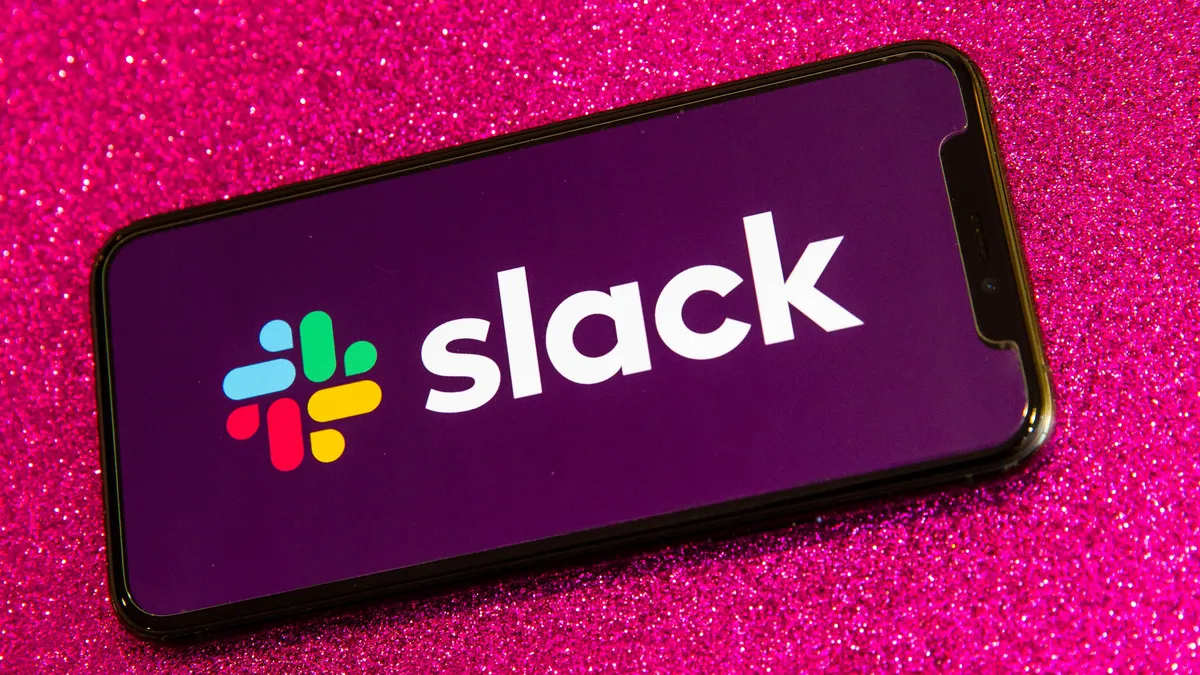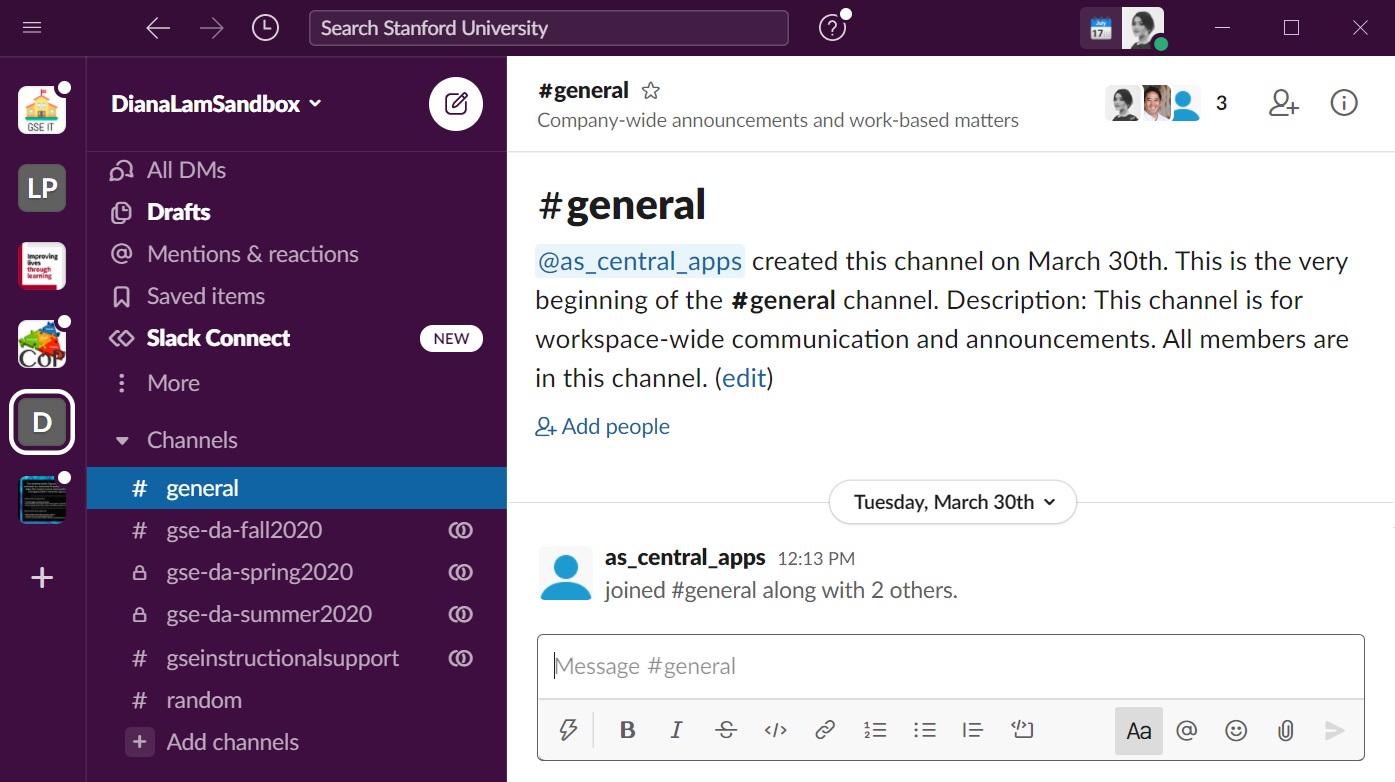Introduction
Welcome to the world of Slack, a popular collaboration platform that allows users to communicate and work together seamlessly. Slack has become a go-to tool for teams and communities looking to stay connected, share ideas, and collaborate effectively, whether they are in the same office or spread across the globe.
If you’re new to Slack and wondering how to join Slack groups, look no further. In this article, we’ll guide you through the process of finding and joining Slack groups, whether it’s for professional networking, industry-specific discussions, or shared interests.
Slack groups are communities where individuals with a common goal, shared interests, or working in the same field come together to exchange ideas, knowledge, and experiences. These groups not only provide a platform for interaction but also facilitate networking opportunities with industry experts, freelancers, like-minded individuals, and colleagues from around the world.
Whether you are a freelancer, a professional looking to expand your network, or simply someone interested in connecting with others who share your passions, joining a Slack group can be a valuable experience. The platform offers a wide range of groups covering various industries, hobbies, and topics of interest.
In the following sections, we’ll walk you through the process of finding and joining Slack groups. We’ll provide step-by-step instructions on how to create a Slack account if you don’t have one already, how to join a Slack group using an invitation link or email invitation, and how to join public Slack groups.
Are you ready to dive into the world of Slack groups? Let’s get started on your journey to join and contribute to vibrant communities where you can learn, grow, and connect with people who share your passions and interests.
What is Slack?
Slack is a cloud-based communication and collaboration tool designed to bring teams together and streamline their workflows. It provides a centralized platform for real-time messaging, file sharing, project management, and integrations with various other tools and applications.
At its core, Slack is like a virtual workspace where team members can interact, share ideas, and collaborate on projects, regardless of their physical location. It offers a range of features that help teams communicate effectively, including channels for organizing conversations, direct messaging for one-on-one discussions, and the ability to create and share files.
One of the key advantages of Slack is its versatility and flexibility. It supports integrations with numerous apps, allowing teams to bring together all their communication and collaboration tools into one place. Popular integrations include project management platforms like Trello and Asana, file sharing services like Google Drive and Dropbox, and video conferencing tools like Zoom and Microsoft Teams.
Slack’s user-friendly interface and intuitive design make it easy for teams to navigate and find the information they need. Whether it’s searching for past conversations, accessing shared files, or quickly catching up on updates, Slack provides a seamless experience that saves time and keeps everyone on the same page.
Another notable feature of Slack is its ability to create channels. Channels are dedicated spaces for specific topics, projects, or teams within an organization. This allows team members to join relevant channels and participate in discussions that are relevant to them. Channels can be set to public, where anyone in the organization can join, or private, where only invited members have access.
In addition to channels, Slack also supports direct messaging, making it easy for team members to have private conversations and collaborate on specific tasks without cluttering the main channel.
Overall, Slack revolutionizes team communication by providing a robust and efficient platform that fosters collaboration, enhances productivity, and facilitates knowledge sharing. Whether you’re part of a small startup or a large multinational company, Slack can help you streamline your workflows and stay connected with your team.
How to Find Slack Groups
If you’re looking to join Slack groups, there are several ways to find and discover communities that align with your interests, industry, or goals. Here are some effective methods to help you find Slack groups:
1. Slack Group Directories: There are various online directories that curate and list Slack groups from different categories. These directories categorize groups based on topics such as technology, marketing, design, entrepreneurship, and more. Some popular directories include Slacklist, Slofile, and Slack Directory. Browse through these directories to find groups that resonate with your interests.
2. Online Communities and Forums: Many online communities and forums have dedicated threads or discussions where users share and recommend Slack groups. Platforms like Reddit, Quora, and LinkedIn groups can be valuable resources for finding relevant Slack communities. Join these communities and actively participate in discussions to discover Slack groups that align with your interests and goals.
3. Industry and Professional Networks: If you’re looking for industry-specific Slack groups, tap into your existing professional networks. Reach out to colleagues, participate in industry events and conferences, and follow influential professionals in your field on social media. Often, these networks will have Slack groups that serve as valuable platforms for networking, knowledge sharing, and collaboration.
4. Social Media: Platforms like Twitter, Facebook, and LinkedIn can be excellent sources for finding Slack groups. Search for relevant hashtags, follow industry influencers, and engage with communities in your field. Oftentimes, community managers or group administrators will share information about their Slack communities on social media, making it easier for you to discover and join.
5. Word of Mouth: Don’t underestimate the power of word of mouth. Ask your colleagues, friends, or industry peers if they are part of any Slack groups or if they can recommend any communities to join. Personal recommendations can lead you to hidden gems and exclusive communities that may not be widely advertised.
Remember, when joining a Slack group, ensure that it aligns with your interests, goals, and values. Take the time to explore the group’s purpose, rules, and guidelines before seeking an invitation to join. Being part of a relevant and engaging Slack community can provide you with valuable connections, insights, and opportunities for personal and professional growth. So, go ahead and start exploring the vast world of Slack groups!
Request to Join a Slack Group
Once you’ve found a Slack group that interests you, the next step is to request to join the community. Most Slack groups have established guidelines and processes for joining, so it’s important to follow the correct procedure. Here’s how you can request to join a Slack group:
1. Contact the Group Admin or Moderator: The first step is to identify the group administrator or moderator. This information is usually available on the group’s website, directory listing, or within the group itself. Reach out to the admin through the designated channels provided and express your interest in joining the group. Be polite, introduce yourself, and explain why you are interested in joining.
2. Show Your Value: In your request to join, it’s essential to showcase your value and how you can contribute to the group. Highlight your relevant skills, experience, and knowledge. Show that you are genuinely interested in the group’s topic and willing to actively participate and engage in meaningful discussions. This will help the admin or moderator understand why you would be a valuable addition to the group.
3. Respect Group Guidelines: Before sending your request, carefully review the group’s guidelines and rules. Ensure that you understand and agree to follow them. Mention in your request that you have familiarized yourself with the guidelines and are committed to adhering to them. This shows respect for the existing community and demonstrates your willingness to be a responsible member.
4. Be Patient and Follow Up if Necessary: After sending your request, give the admin or moderator some time to review and respond. Depending on the group’s size and activity level, it may take a while for them to process requests. If you haven’t heard back within a reasonable timeframe, it’s acceptable to send a follow-up message politely asking about the status of your request.
5. Engage with the Group Once Accepted: Once your request is approved, congratulations! Make sure to introduce yourself to the group and start engaging in conversations. Actively contribute by sharing valuable insights, asking questions, and interacting with other members. Building relationships and actively participating will help you establish yourself within the community and make the most out of your Slack group membership.
Remember, different Slack groups may have different processes for joining, so it’s essential to follow their specific instructions. Be respectful, genuine, and enthusiastic while requesting to join a Slack group, and you’re sure to find yourself welcomed into a vibrant and engaging community.
How to Create a Slack Account
If you’re new to Slack and want to join Slack groups, you’ll first need to create a Slack account. Follow these steps to set up your account:
1. Visit the Slack Website: Start by visiting the official Slack website at slack.com.
2. Click on “Get Started”: Once you’re on the Slack homepage, click on the “Get Started” button. You’ll be redirected to the account creation page.
3. Enter your Email Address: On the account creation page, enter your email address in the designated field. Make sure to use a valid email address that you have access to as you’ll need it for account verification and communication purposes.
4. Create a Password: Choose a strong and secure password for your Slack account. Remember to follow best practices for password creation, such as using a combination of uppercase and lowercase letters, numbers, and symbols.
5. Verify your Email: After creating a password, Slack will send a verification email to the address you provided. Check your email inbox and click on the verification link to confirm your account.
6. Set your Team Name: Once your account is verified, you’ll be prompted to set your team name. This is the name that will be associated with your Slack account and will be visible to other members of the groups you join.
7. Invite Team Members (Optional): If you’re using Slack for a specific team or organization, you have the option to invite team members during the account creation process. You can skip this step if you’re creating an account for personal use.
8. Customize your Profile: After setting up your team name, you can customize your profile by adding a profile picture and providing additional information such as your name and job title. This helps other members of the Slack groups you join to identify you and connect with you more easily.
9. Explore Slack: Once your account is created, you’ll be directed to your Slack workspace. Take some time to explore the different features and familiarize yourself with the interface. You’re now ready to start joining Slack groups and connecting with like-minded individuals.
Creating a Slack account is quick and easy. By following these steps, you’ll be able to create your account and access the multitude of features and benefits that Slack offers for effective team communication and collaboration.
How to Join a Slack Group Using an Invitation Link
If you have received an invitation link to join a specific Slack group, here’s a step-by-step guide on how to join:
1. Click on the Invitation Link: Open the email or message containing the invitation link. Click on the provided link to be directed to the Slack group’s invitation page.
2. Verify your Email: On the invitation page, you may be prompted to verify your email address. This step ensures that you have a valid email associated with your Slack account for communication.
3. Choose your Display Name: Next, you’ll have the option to choose your display name. This is the name that will be visible to other members of the Slack group. You may use your actual name or a username depending on your preference.
4. Set your Password: If you have not set a password for your Slack account previously, you’ll be prompted to create one at this stage. Choose a strong and secure password that you can remember easily.
5. Customize your Profile (Optional): After setting your display name and password, you have the option to customize your profile further. Adding a profile picture and providing additional information can help other members recognize and connect with you.
6. Join the Slack Group: Once you have completed the previous steps, click on the “Join Group” or similar button to finalize the process. You’ll be automatically added to the Slack group, and you can start engaging with other members right away.
7. Start Participating: Upon joining the Slack group, take some time to explore the channels, conversations, and resources available. Introduce yourself to the community, participate in discussions, and contribute where you can. Building connections and actively engaging will maximize your experience within the Slack group.
Joining a Slack group using an invitation link is a simple and straightforward process. By following these steps, you can seamlessly become a part of the community and start benefitting from the knowledge sharing, networking, and collaboration opportunities that the Slack group offers.
Joining a Slack Group through Email Invitation
If you have received an email invitation to join a Slack group, here’s a step-by-step guide on how to join:
1. Open the Email Invitation: Start by opening the email that contains the invitation to the Slack group. Make sure to read the email thoroughly and understand the purpose and details of the group.
2. Click on the “Join the Group” or Similar Button: Within the email, you should see a button or link that says something like “Join the Group” or “Accept Invitation.” Click on the provided link to accept the invitation and be directed to the Slack group’s sign-up page.
3. Create a Slack Account (if needed): If you don’t already have a Slack account, you’ll be prompted to create one. Fill in the necessary details such as your name, email address, and password. Choose a strong and memorable password to secure your account.
4. Verify your Email Address: Slack may send a verification email to the address you provided during the account creation process. Check your email inbox and click on the verification link to confirm your account.
5. Set your Display Name: On the Slack account setup page, you’ll have the option to set your display name. This is the name that will be visible to other members of the Slack group. You can use your actual name or a display name based on your preference.
6. Customize your Profile (Optional): After setting your display name, you have the option to customize your profile further. This step may include adding a profile picture and providing additional information about yourself. Customizing your profile helps other members recognize and connect with you.
7. Join the Slack Group: Once you have completed the previous steps, click on the “Join Group” or similar button to finalize the process. You will be automatically added to the Slack group, and you can start engaging with other members right away.
8. Explore and Participate: Upon joining the Slack group, take some time to familiarize yourself with the channels, conversations, and resources available. Introduce yourself to the community, participate in discussions, and contribute where you can. Building connections and actively engaging will maximize your experience within the Slack group.
Joining a Slack group through an email invitation is a simple process that allows you to seamlessly become part of a community. By following these steps, you’ll be able to join the group and enjoy the benefits of networking, knowledge sharing, and collaboration that the Slack group offers.
Joining a Public Slack Group
Joining a public Slack group is a straightforward process that allows you to connect with like-minded individuals and engage in discussions on specific topics. Here’s a step-by-step guide on how to join a public Slack group:
1. Search for Public Slack Groups: Start by searching for public Slack groups that align with your interests or goals. You can use online directories, search engines, or social media platforms to discover groups related to your industry, hobbies, or passions.
2. Find an Invitation Link: Once you have identified a public Slack group that interests you, look for an invitation link. These links are often shared on websites, social media, or forums associated with the group. In some cases, group administrators may have posted an invitation link that you can directly access.
3. Open the Invitation Link: Click on the invitation link to be directed to the Slack group’s sign-up page.
4. Provide your Email Address: On the sign-up page, enter your email address in the designated field. Make sure to use a valid email address that you have access to as you’ll need it for account verification and communication purposes.
5. Create a Password: Choose a strong and secure password for your Slack account. Follow best practices for password creation, such as using a combination of uppercase and lowercase letters, numbers, and symbols.
6. Verify your Email: After creating a password, Slack will send a verification email to the address you provided. Check your email inbox and click on the verification link to confirm your account.
7. Set your Display Name: Once your account is verified, you’ll be prompted to set your display name. This is the name that will be visible to other members of the public Slack group. You may use your actual name or a username depending on your preference.
8. Customize your Profile: After setting your display name, you have the option to customize your profile by adding a profile picture and providing additional information, such as your location or areas of expertise. Customizing your profile helps other members recognize and connect with you.
9. Join the Public Slack Group: Once you have completed the previous steps, click on the “Join Group” or similar button to finalize the process. You’ll be automatically added to the public Slack group, and you can start participating in discussions and connecting with other members.
Remember, public Slack groups offer a platform for open discussions and networking. Respect the group’s guidelines, engage in meaningful conversations, and contribute positively to the community. By joining public Slack groups, you can expand your network, gain valuable insights, and build relationships with individuals who share your interests.
Benefits of Joining Slack Groups
Joining Slack groups can bring numerous benefits and opportunities for personal and professional growth. Here are some of the advantages of becoming part of a Slack group:
1. Networking and Community Building: Slack groups provide a platform to connect with like-minded individuals, industry professionals, and experts in your field. Engaging in conversations, sharing ideas, and collaborating within these communities can help you build a strong network and expand your connections.
2. Knowledge Sharing and Learning: Slack groups often serve as knowledge-sharing hubs. By joining these communities, you gain access to a wealth of information, insights, and experiences shared by other members. Engaging in discussions, asking questions, and sharing your own expertise can help you accelerate your learning and stay updated with industry trends.
3. Collaboration and Project Opportunities: Slack groups can be a fertile ground for finding collaboration opportunities or potential projects. Connecting with individuals who share similar interests or are in complementary roles can lead to partnerships, freelance gigs, or collaborative projects. These collaborations can boost your professional growth and broaden your skillset.
4. Professional Development: Joining Slack groups allows you to gain exposure to diverse perspectives, industry best practices, and emerging trends. You can participate in discussions, attend webinars or virtual events organized by the group, and learn from industry leaders. This exposure can contribute to your professional development and help you stay ahead in your career.
5. Community Support: Slack groups often foster a supportive and inclusive community. Whether you’re facing professional challenges, seeking advice, or celebrating accomplishments, these communities offer a sense of belonging. Members can provide guidance, support, and encouragement, creating a safe space for sharing experiences and seeking support.
6. Opportunities for Collaboration and Partnerships: Slack groups can lead to exciting collaboration opportunities and partnerships. Engaging and connecting with individuals who have complementary skills and interests can open doors to new projects, joint ventures, or business opportunities.
7. Stay Updated and Informed: Slack groups are often buzzing with discussions on the latest industry news, trends, and updates. By participating in these groups, you can stay informed about relevant developments, new tools, and emerging technologies that impact your profession.
Overall, joining Slack groups can provide a supportive community, opportunities for networking, knowledge sharing, collaboration, and professional development. It’s a chance to connect with others who share your interests, expand your horizons, and stay current in your field. So, find and join relevant Slack groups to unlock these benefits and take your personal and professional growth to new heights.
Conclusion
Joining Slack groups can be a game-changer for networking, knowledge sharing, and collaboration. Whether you’re looking to connect with like-minded individuals, expand your professional network, or gain insights from industry experts, Slack groups offer a wealth of benefits.
In this article, we’ve explored various ways to find Slack groups, including using directories, online communities, and social media platforms. We’ve also discussed the steps to join Slack groups through invitation links, email invitations, and public group sign-ups.
By joining Slack groups, you gain the opportunity to engage in discussions, share ideas, and learn from others. These communities provide a supportive environment where you can connect with people who share your interests, seek advice, and collaborate on projects.
Some of the key benefits of joining Slack groups include expanding your professional network, staying updated with industry trends and news, accessing collaborative opportunities, and gaining valuable insights and knowledge.
Remember, when joining Slack groups, it’s important to be respectful, contribute meaningfully, and adhere to community guidelines. Actively participate, share your expertise, and build relationships to truly maximize the benefits of your membership.
So, why wait? Start exploring the vast world of Slack groups today and take advantage of the opportunities and connections that await you. Join relevant communities, engage with other members, and unlock the power of collaboration and networking through the power of Slack.

























